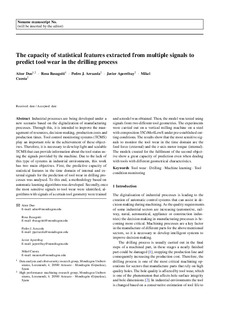Izenburua
The capacity of statistical features extracted from multiple signals to predict tool wear in the drilling processEgilea
Argitalpen data
2019Bertsioa
PostprintaDokumentu-mota
ArtikuluaArtikuluaHizkuntza
IngelesaEskubideak
© Springer-Verlag London Ltd., part of Springer Nature 2019Sarbidea
Sarbide bahituaBahituraren amaiera data
2020-01-22Argitaratzailearen bertsioa
https://doi.org/10.1007/s00170-019-03300-5Non argitaratua
The International Journal of Advanced Manufacturing Technology Vol. 102. Nº 5–8. Pp 2133–2146. June, 2019Argitaratzailea
Springer VerlagGako-hitzak
tool wearDrilling
Machine learning
Tool condition monitoring
Laburpena
Industrial processes are being developed under a new scenario based on the digitalisation of manufacturing processes.Through this, it is intended to improve the management of resources, ... [+]
Industrial processes are being developed under a new scenario based on the digitalisation of manufacturing processes.Through this, it is intended to improve the management of resources, decision-making, production costs and productiontimes. Tool control monitoring systems (TCMS) play an important role in the achievement of these objectives. Therefore, itis necessary to develop light and scalable TCMS that can provide information about the tool status using the signals providedby the machine. Due to the lack of this type of systems in industrial environments, this work has two main objectives. First,the predictive capacity of statistical features in the time domain of internal and external signals for the prediction of toolwear in drilling processes was analysed. To this end, a methodology based on automatic learning algorithms was developed.Secondly, once the most sensitive signals to tool wear were identified, algorithms with signals of a certain tool geometrywere trained and a model was obtained. Then, the model was tested using signals from two different tool geometries. Theexperiments were carried out on a vertical milling machine on a steel with composition 35CrMo4LowS under pre-establishedcutting conditions. The results show that the most sensitive signals to monitor the tool wear in the time domain are the feedforce (external) and thez-axis motor torque (internal). The models created for the fulfilment of the second objective show agreat capacity of prediction even when dealing with tools with different geometrical characteristics. [-]





















